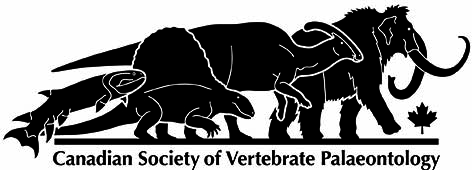Cranial ornamentation of a large Brachydectes newberryi (Recumbirostra: Lysorophia) from Linton, Ohio.
DOI:
https://doi.org/10.18435/vamp29341Keywords:
Recumbirostra, Lysorophia, Linton, Permo-Carboniferous, dermal ornament, ontogenyAbstract
Although the cranial anatomy of the lysorophian tetrapod Brachydectes has been reported in detail recently, many attributes of the group are inadequately known, and lysorophian systematics remain unclear. One under-described aspect of the genus is the development and variation of cranial ornamentation. Whereas the smallest skulls (< 5 mm in length) lack sculpturing, ornamentation increases in progressively larger specimens and is conspicuous in the largest (> 30 mm skull length) individuals. It includes rugose ornament on the anterior cranial roof elements (frontals and anterior parietals) and pustular ornament on the posterior elements (posterior parietals and postparietals). Such ornamentation is unique within recumbirostrans and is identified as an ontogenetic feature.Downloads
References
Anderson J.S., D. Scott and R.R. Reisz. 2009. Nannaroter mckinziei, a new ostodolepid ‘microsaur’(Tetrapoda, Lepospondyli, Recumbirostra) from the Early Permian of Richards Spur (Ft. Sill), Oklahoma. Journal of Vertebrate Paleontology 29, 379-388.
Bolt J.R. and R.J. Wassersug. 1975. Functional morphology of the skull in Lysorophus: a snake-like Paleozoic amphibian (Lepospondyli). Paleobiology 1, 320-332.
Boy J.A. 1988. Über einige Vertreter der Eryopoidea (Amphibia: Temnospondyli) aus dem europäischen Rotliegend (? höchstes Karbon—Perm) 1. Sclerocephalus. Paläontologische Zeitschrift 62, 107–132.
Carroll R.L. and D. Baird. 1968. The Carboniferous amphibian Tuditanus (Eosauravus) and the distinction between microsaurs and reptiles. American Museum novitates 2337, 1-50.
Carroll R.L. and P. Gaskill. 1978 The order Microsauria. Memoirs of the American Philosophical Society 126, 1–211.
Cope E.D. 1868. Synopsis of the extinct Batrachia of North America. Proceedings of the Academy of Natural Scienes of Philadelphia 20, 208–221.
Fox R.C. and M.C. Bowman. 1966 Osteology and relationships of Captorhinus aguti (Cope) (Reptilia: Captorhinomorpha). The University of Kansas Paleontological Contributions, Vertebrata 2, 1–79.
Glienke S. 2013. A taxonomic revision of Batropetes (Amphibia, Microsauria) from the Rotliegend (basal Permian) of Germany. Neues Jahrbuch für Geologie und Paläontologie-Abhandlungen 269, 73–96.
Glienke S. 2015. Two new species of the genus Batropetes (Tetrapoda, Lepospondyli) from the Central European Rotliegend (basal Permian) in Germany. Journal of Vertebrate Paleontology 35, e918041.
Hembree D.I., L.D. Martin and S.T. Hasiotis. 2004. Amphibian burrows and ephemeral ponds of the Lower Permian Speiser Shale, Kansas: evidence for seasonality in the midcontinent. Palaeogeography, Palaeoclimatology, Palaeoecology, 203, 127–152.
Henrici A.C., T. Martens, D.S. Berman and S.S. Sumida. 2011. An ostodolepid ‘microsaur’(Lepospondyli) from the Lower Permian Tambach Formation of central Germany. Journal of Vertebrate Paleontology 31, 997-1004.
Huttenlocker A.K., J.D. Pardo and B.J. Small. 2005. An earliest Permian nonmarine vertebrate assemblage from the Eskridge Formation, Nebraska. New Mexico Museum of Natural History and Science Bulletin 30, 133–143.
Huttenlocker A.K., J.D. Pardo, B.J. Small and J.S. Anderson. 2013. Cranial morphology of recumbirostrans (Lepospondyli) from the Permian of Kansas and Nebraska, and early morphological evolution inferred by micro-computed tomography. Journal of Vertebrate Paleontology 33, 540–552.
Jenkins I., Thomason J.J., and D.B. Norman. 2002. Primates and engineering principles: applications to craniodental mechanisms in ancient terrestrial predators. Senckenbergiana lethaea 82, 223–240.
Maddin H.C., J.C. Olori and J. S. Anderson. 2011. A redescription of Carrolla craddocki (Lepospondyli: Brachystelechidae) based on high-resolution CT, and the impacts of miniaturization and fossoriality on morphology. Journal of Morphology 272, 722–743.
Pardo J.D., M. Szostakiwskyj, and J. S. Anderson. 2015. Cranial morphology of the brachystelechid ‘microsaur’ Quasicaecilia texana Carroll provides new insights into the diversity and evolution of braincase morphology in recumbirostran ‘microsaurs’. PloS one 10, e0130359.
Pardo J.D. and J.S. Anderson. 2016. Cranial morphology of the Carboniferous-Permian tetrapod Brachydectes newberryi (Lepospondyli, Lysorophia): New Data from µCT. PloS one 11, e0161823.
Pardo J.D., M. Szostakiwskyj, P.E. Ahlberg, J.S. and Anderson. 2017 Hidden morphological diversity among early tetrapods. Nature 546, 642–645.
Rinehart L.F. and S.G. Lucas. 2013. The functional morphology of dermal bone ornamentation in temnospondyl amphibians. The Triassic System. New Mexico Museum of Natural History and Science, Bulletin 61, 524–532.
Romer A.S. 1969 The cranial anatomy of the Permian amphibian Pantylus. Breviora 314, 1–37.
Schoch R.R. 2003. Early larval ontogeny of the Permo‐Carboniferous temnospondyl Sclerocephalus. Palaeontology 46, 1055–1072.
Schoch R.R. 2002. The evolution of metamorphosis in temnospondyls. Lethaia 35, 309–327.
Sollas W.J. 1920. XI.-On the structure of Lysorophus, as exposed by serial sections. Philosophical Transaction Royal Society London B 209, 481–527.
Szostakiwskyj M., J.D. Pardo and J.S. Anderson. 2015. Micro-CT study of Rhynchonkos stovalli (Lepospondyli, Recumbirostra), with description of two new genera. PLoS One 10, e0127307.
Vallin G. and M. Laurin. 2004. Cranial morphology and affinities of Microbrachis, and a reappraisal of the phylogeny and lifestyle of the first amphibians. Journal of Vertebrate Paleontology 24, 56–72.
Wellstead C.F. 1991. Taxonomic revision of the Lysorophia, Permo-Carboniferous lepospondyl amphibians. Bulletin American Museum of Natural History 209, 1-90.
Wellstead C.F. 1998. Order Lysorophia: in Encyclopedia of paleoherpetology, Part 1: Lepospondyli (P. Wellnhofer, ed.).Verlag Dr. Friedrich Pfeil, Munchen 133–148.
Downloads
Published
How to Cite
Issue
Section
License
Copyright (c) 2018 Arjan Mann

This work is licensed under a Creative Commons Attribution 4.0 International License.
Submission of an article to Vertebrate Anatomy Morphology Palaeontology will be taken to mean that the article is an original work and not previously published or under consideration for publication elsewhere.
If the article is accepted for publication, it will be published on-line under Creative Commons Attribution 4.0 International (CC By 4.0) meaning:
Attribution — You must give appropriate credit, provide a link to the license, and indicate if changes were made. You may do so in any reasonable manner, but not in any way that suggests the licensor endorses you or your use.
No additional restrictions — You may not apply legal terms or technological measures that legally restrict others from doing anything the license permits.






